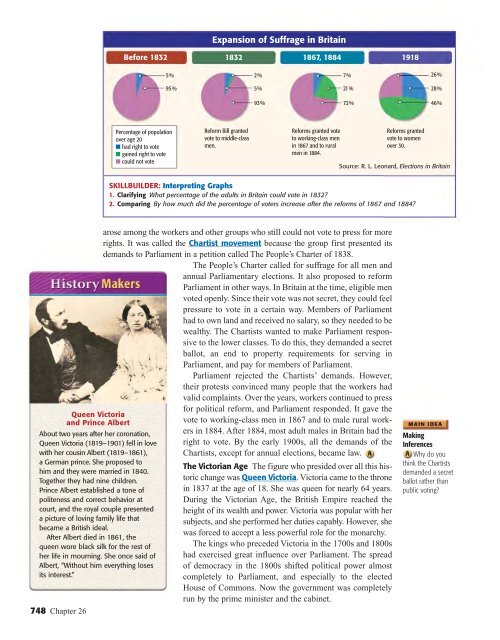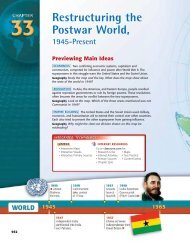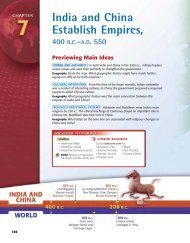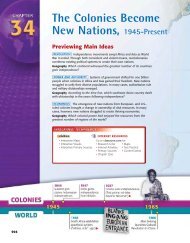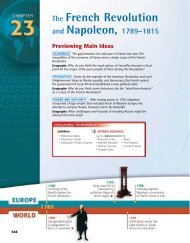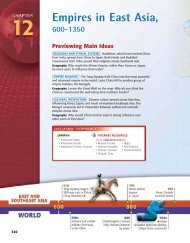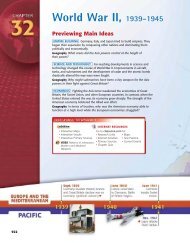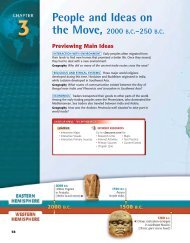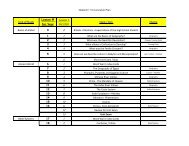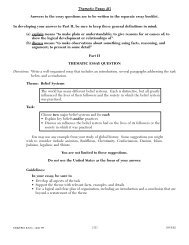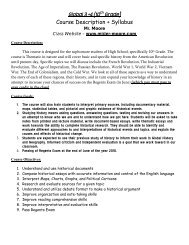The Industrial Revolution, 1700– 1900 Previewing Main Ideas
The Industrial Revolution, 1700– 1900 Previewing Main Ideas
The Industrial Revolution, 1700– 1900 Previewing Main Ideas
You also want an ePaper? Increase the reach of your titles
YUMPU automatically turns print PDFs into web optimized ePapers that Google loves.
Queen Victoria<br />
and Prince Albert<br />
About two years after her coronation,<br />
Queen Victoria (1819–1901) fell in love<br />
with her cousin Albert (1819–1861),<br />
a German prince. She proposed to<br />
him and they were married in 1840.<br />
Together they had nine children.<br />
Prince Albert established a tone of<br />
politeness and correct behavior at<br />
court, and the royal couple presented<br />
a picture of loving family life that<br />
became a British ideal.<br />
After Albert died in 1861, the<br />
queen wore black silk for the rest of<br />
her life in mourning. She once said of<br />
Albert, “Without him everything loses<br />
its interest.”<br />
748 Chapter 26<br />
Expansion of Suffrage in Britain<br />
Before 1832 1832 1867, 1884 1918<br />
5 %<br />
95 %<br />
Percentage of population<br />
over age 20<br />
■ had right to vote<br />
■ gained right to vote<br />
■ could not vote<br />
Reform Bill granted<br />
vote to middle-class<br />
men.<br />
arose among the workers and other groups who still could not vote to press for more<br />
rights. It was called the Chartist movement because the group first presented its<br />
demands to Parliament in a petition called <strong>The</strong> People’s Charter of 1838.<br />
<strong>The</strong> People’s Charter called for suffrage for all men and<br />
annual Parliamentary elections. It also proposed to reform<br />
Parliament in other ways. In Britain at the time, eligible men<br />
voted openly. Since their vote was not secret, they could feel<br />
pressure to vote in a certain way. Members of Parliament<br />
had to own land and received no salary, so they needed to be<br />
wealthy. <strong>The</strong> Chartists wanted to make Parliament responsive<br />
to the lower classes. To do this, they demanded a secret<br />
ballot, an end to property requirements for serving in<br />
Parliament, and pay for members of Parliament.<br />
Parliament rejected the Chartists’ demands. However,<br />
their protests convinced many people that the workers had<br />
valid complaints. Over the years, workers continued to press<br />
2 %<br />
5 %<br />
for political reform, and Parliament responded. It gave the<br />
vote to working-class men in 1867 and to male rural workers<br />
in 1884. After 1884, most adult males in Britain had the<br />
right to vote. By the early <strong>1900</strong>s, all the demands of the<br />
Chartists, except for annual elections, became law.<br />
<strong>The</strong> Victorian Age <strong>The</strong> figure who presided over all this historic<br />
change was Queen Victoria. Victoria came to the throne<br />
in 1837 at the age of 18. She was queen for nearly 64 years.<br />
During the Victorian Age, the British Empire reached the<br />
height of its wealth and power. Victoria was popular with her<br />
subjects, and she performed her duties capably. However, she<br />
was forced to accept a less powerful role for the monarchy.<br />
<strong>The</strong> kings who preceded Victoria in the 1700s and 1800s<br />
had exercised great influence over Parliament. <strong>The</strong> spread<br />
of democracy in the 1800s shifted political power almost<br />
completely to Parliament, and especially to the elected<br />
House of Commons. Now the government was completely<br />
run by the prime minister and the cabinet.<br />
7 %<br />
21 %<br />
26 %<br />
28 %<br />
93 % 72 % 46 %<br />
Reforms granted vote<br />
to working-class men<br />
in 1867 and to rural<br />
men in 1884.<br />
Reforms granted<br />
vote to women<br />
over 30.<br />
Source: R. L. Leonard, Elections in Britain<br />
SKILLBUILDER: Interpreting Graphs<br />
1. Clarifying What percentage of the adults in Britain could vote in 1832?<br />
2. Comparing By how much did the percentage of voters increase after the reforms of 1867 and 1884?<br />
Making<br />
Inferences<br />
Why do you<br />
think the Chartists<br />
demanded a secret<br />
ballot rather than<br />
public voting?


